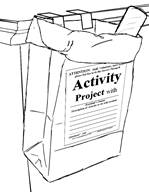renewal cycles. Complete
some now & some later.
and Get 25% off
the Total price!
Buy 3 Courses
and Get 30% off
the Total price!
Buy 4 Courses
and Get 35% off
the Total price!
| Create Account | Login | |

Section 26
Inservice Training Sheets
Table of Contents | NCCAP/NCTRC CE Booklet

The In-service Sheets can serve as an informal method to in-service your entire facility staff, as well as volunteers and interested family members. Permission is granted to duplicate these sheets found at the end of the Manual. Once they are duplicated, cut them in half. Sheets are then placed in the corresponding bag, once you have implemented the ST® Object Manipulation Activity with the resident.
Obviously bag size will vary with the size of your resident’s project. Use either paper or plastic bags. Food storage plastic bags or small sized trash bags cuffed at the top work well taped to the night stand or place in another location in a resident’s room that is in clear view. With ST® Projects the old “out of sight, out of mind” adage could not be more true.
In Order for You to Get Staff Support:
#1. The projects need to be in sight, readily available, via bags taped to the night stand, not stored in the activity room. Thus, the projects suggested in all five volumes of the Alzheimer’s and Low Functioning Series are constructed from no or low cost materials.
#2. Staff, volunteers, and families need to be “given permission” to utilize, what may be viewed as the “private property” of the Activity Department. An in-service, either formal or informal, works well to “invite” use of the projects.
#3. Staff, volunteers, and families need to be trained how to
a. introduce the ST® Activity
b. adapt their level of instruction to the resident
c. utilize any physical adaptations necessary.
NCCAP/NCTRC CE Booklet
Forward to Section 27
Back to Section 25
Table of Contents
Top


